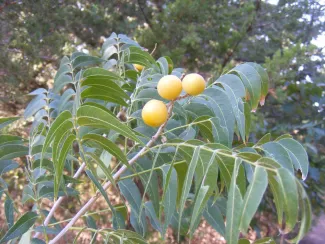Western soapberry trees occur across the state but are much more common within the western half. They are easily recognized by their golden, somewhat translucent fruit clusters that persist well into winter and turn black over time. Such peculiar trees, especially the fruits, must have considerable wildlife value, but just how much?

Western soapberry usually occurs in groves as the trees readily produce root offshoots through suckering. It is widely recognized by its half-inch wide fruits that turn translucent, and eventually black, with age.
By in large, the greatest value of the soapberry tree is for wildlife cover. Dense soapberry groves can define a woodland, fencerow, or creek, and this cover is readily used by deer, wild turkey, and many other species as they travel, rest, and/or escape predators. Many birds also nest among the branches of soapberry trees or use the trees as cover as they search for insects.
As for food, the soapberry’s value is much less. Although striking, the fruits receive little attention from mammals or birds. White-tailed deer will nibble on the fruits, but they rarely make up more than a trace of their diet. Eastern bluebirds and American robins also eat the fruits and/or seeds to some extent, as do some rodents.
Perhaps the greatest food value of the soapberry tree is when deer target the leaves. Although not a preferred food, white-tailed deer will eat the leaves during the growing season. They also seem to enjoy the leaves once the foliage begins to change color during the fall. Young soapberry trees can be especially vulnerable to deer browsing.
Overall, the food value of the soapberry tree is relatively low, but these native trees have value in the habitats they occur. They also serve as host plants for various insects, especially the soapberry hairstreak butterfly.
It must be mentioned that some people can have a sensitivity to the fruits, leaves, and roots of western soapberry. Its name derives from its historic use as a soap substitute, but misuse can lead to a rash or other health difficulties, though this varies widely with a person’s individual susceptibility.
For landowners and managers wishing to have western soapberry on their property, young trees are occasionally available through commercial nurseries. Stem cuttings taken during the spring and treated with a growth hormone can also root with success. Seed planting can be fruitful, but this usually requires time and attention to be sure the seeds are carefully and properly scarified and stratified for proper germination. One thing is for sure, no matter how these trees may establish onto a property, about 50 feet is as high as they get, and much shorter trees usually occur.